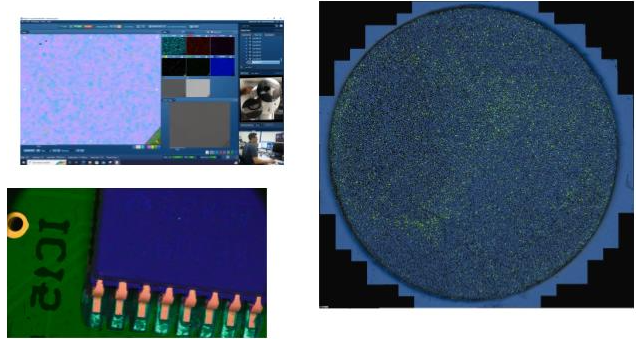Backscattered Electron and X-Ray (BEX) imaging is a method for Scanning Electron Microscopy (SEM) which obtains data from both X-Ray sensors, such as silicon drift detector, and Backscattered Electron (BSE) sensors concurrently, using one sensor package.
The combined signals generate high-resolution color images that contain crystallographic, topographic, and compositional data, which can be obtained using the low dwell times of an imaging system during operation under ‘standard’ SEM imaging conditions.
Examples of BEX Imaging

Top Left: Navigation of a dissimilar metal braze joint using BEX. 20 kV, 1 nA. acquired in 15 seconds. Bottom Left: High-resolution BEX image of an electronic chip. 20 kV, 1.5 nA, 2K image acquired in 10 seconds. Right BEX map of whole 12 mm diameter sample stub 20 kV, 2 nA, acquired in 30 minutes. Image Credit: Oxford Instruments
Imaging Technologies in SEM
Imaging with Secondary Electrons
Historically, the most popular modality has been Secondary Electron (SE) imaging. This technique involves the detection of low-energy electrons (~50 eV) that have been ejected from the sample due to inelastic interactions between the sample surface and the primary beam.
An Everhart-Thornley detector comprises a positively biased Faraday cage, a photomultiplier, and a scintillator to detect the electrons.
The produced signal originates from near the sample surface. As the primary beam’s angle of incidence moves away from its normal position, the number of electrons that escape the bulk material increases. This results in SE imaging containing information about local sample topography.


Top: Secondary Electrons (green) are generated near the sample surface and produce. Bottom: a greyscale image containing information about sample topography. 20 kV, 1 nA, 15 seconds to acquired. Image Credit: Oxford Instruments
Imaging with Backscattered Electrons
Backscattered Electron (BSE) imaging detects electrons that originate from deeper within the sample.
The BSE electrons are higher energy as they originate from elastic interactions between the sample and the primary beam, which changes the trajectory of the incident electrons, resulting in them being scattered back from the sample surface.
Due to the remote position from the sample leading to a very low signal, an SE detector is unsuccessful in measuring these electrons.
A BSE detector typically involves p-n semiconductors arranged directly below the SEM objective lens for maximum signal collection.
The scattering interactions producing the BSE signal are significantly more robust in samples comprising heavier elements. As a result, a BSE image contains information regarding sample composition, as heavier phases appear brighter.
The basic operation of BSE detectors provides atomic number contrast. However, arranging the sensors into two or more segments allows the signals from each sensor to be combined to provide topographical information.


Top: Backscattered Electrons (red) are generated from below the sample surface and produce Bottom: a greyscale image containing information about sample composition. 20 kV, 1 nA, 15 seconds to acquired. Image Credit: Oxford Instruments
Imaging with BEX
BEX is the combination of BSE and X-Ray sensors, which are placed directly below the objective lens.
The X-Ray sensors are typically silicon drift detectors (SDDs), and these are used to measure characteristic X-Ray emissions produced during sample irradiation by the SEM electron beam in the same way as an EDS detector.
The collected X-Ray signal is processed using software algorithms to identify present elements automatically. These elements are subsequently assigned colors layered with the signal from the BSE detector to deliver a final image.
Comparing a BEX imaging system to SE or BSE imaging, the former provides more information regarding sample composition and elemental distribution within the same acquisition time and using the same operating conditions.
Unlike an EDS detector, a BEX imaging system has exceptionally high solid-angle sensors. This allows the collection of X-Ray information at normal imaging speeds and with typical imaging beam currents (~1 nA).
Since the SDD is positioned near the objective lens, shadowing effects from sample topography are eliminated and sample investigation can be carried out at a broader range of working distances.


Top: Backscattered Electrons (red) and X-Rays (blue) are detected and combined to produce Bottom: a color image of sample composition. 20 kV, 1 nA, 15 seconds to acquired. Image Credit: Oxford Instruments

This information has been sourced, reviewed and adapted from materials provided by Oxford Instruments.
For more information on this source, please visit Oxford Instruments.